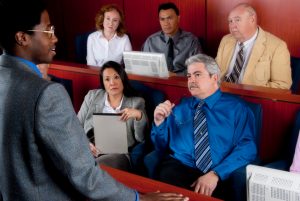Grasping the Art of Trial Presentations: Key Methods for Reliable Legal Arguments
Grasping the Art of Trial Presentations: Key Methods for Reliable Legal Arguments
Blog Article
Browsing the Complexities of Test Presentations: Tips for Seamless Shipment and Compelling Disagreements
In the realm of legal procedures, the art of test discussion stands as a critical determinant of success. The complexities fundamental in trial discussions need a fragile equilibrium of ability, approach, and skill.

Understanding Trial Goals
To properly browse a trial, it is important to have a clear understanding of the goals that require to be attained. Prior to entering the courtroom, legal groups need to specify their objectives and wanted outcomes. These objectives act as directing principles throughout the trial, shaping methods and affecting decision-making procedures.
Recognizing test purposes entails a thorough evaluation of the instance, lawful criteria, and the customer's ideal passions. Trial Presentations. It calls for a thorough exam of the realities, recognizing vital concerns, and preparing for possible difficulties. By setting particular and measurable objectives, lawyers can customize their presentations and arguments to straighten with the wanted results
Furthermore, a clear grasp of trial purposes allows legal teams to focus on proof, witnesses, and legal arguments properly. It permits the advancement of a coherent story that reverberates with the judge and jury, reinforcing the general case discussion.

Organizing Evidence Efficiently
Having a clear understanding of test goals lays the structure for organizing evidence successfully in legal process. By lining up the discussion of evidence with the wanted results of the trial, legal groups can enhance their arguments and improve their persuasiveness.
One more key aspect in arranging evidence effectively is developing a logical flow. Offering evidence in a systematic and sequential way can aid develop an engaging story that sustains the lawful arguments being made. Furthermore, utilizing aesthetic help such as graphes, timelines, or charts can better enhance the organization of proof and assist in clearing up intricate relationships or sequences of occasions.
Furthermore, guaranteeing that all evidence offered is admissible and appropriate to the case is necessary. Irrelevant or inadmissible proof can take away from the toughness of the debate and potentially harm the trustworthiness of the offering event. Therefore, a precise evaluation and choice procedure must be taken on to consist of just one of the most legally sound and impactful evidence in the test discussion.
Crafting Persuasive Stories
Crafting compelling stories plays a critical role in providing persuasive debates during lawful procedures. When creating a narrative for a test presentation, it is essential to develop a clear storyline that highlights crucial points and links them in a coherent way. By weaving with each other evidence, testament, and legal debates into a convincing and natural narrative, lawful professionals can successfully advocate for their clients and raise the possibility of a desirable outcome in the court.
Mastering Visual Help
Reliable use of aesthetic help is key to improving the influence and clarity of trial discussions. Aesthetic help, when utilized tactically, have the power to streamline intricate information, strengthen crucial factors, and leave a lasting perception on the discretionary. To understand aesthetic help in trial presentations, it is important to make certain that they are clear, succinct, and relevant to the disagreements being made.
When integrating aesthetic help, such as graphes, timelines, photos, or charts, right into a trial presentation, it is necessary to maintain them visually appealing yet expert. The visuals must match the verbal arguments, providing a graph of the info being discussed without overwhelming the target market with unneeded details.
Moreover, experimenting the visual aids beforehand is important to ensure a smooth delivery throughout the test. Familiarizing oneself with the content, shifts, and timings of each aesthetic help can help maintain the circulation of the presentation and stop technological glitches that may arise.
Delivering Impactful Closing Arguments
A compelling closing debate serves as the end result of a trial discussion, encapsulating the core story and persuading the court and court towards a desirable decision. Begin by detailing the main disagreements that support your client's placement, emphasizing why the proof offered throughout the trial sustains your story.
In addition, including psychological appeal can further enhance your closing disagreement. Eventually, a well-crafted closing disagreement must leave a long-term impact, engaging the court and court to rule in your customer's support.
Verdict
In verdict, understanding test discussions entails recognizing purposes, arranging proof, crafting stories, using visual aids, and delivering dig this impactful closing arguments. By executing these strategies effectively, lawyers can present their instance flawlessly and make engaging disagreements in the court. It is important to navigate the complexities of test discussions with precision and skill to achieve success in lawful procedures.
By lining up the presentation of proof with the wanted results of the trial, lawful groups can strengthen their arguments and boost their persuasiveness (Trial Presentations). To grasp visual help in test presentations, it is crucial to make certain that site here they are clear, succinct, and appropriate to the arguments being made
An engaging closing disagreement offers as the end result of a trial discussion, encapsulating the core narrative and encouraging the index judge and court towards a favorable choice. Begin by describing the main disagreements that support your customer's position, stressing why the evidence offered throughout the trial sustains your narrative.In verdict, grasping trial discussions involves comprehending objectives, arranging evidence, crafting narratives, utilizing aesthetic aids, and providing impactful closing arguments.
Report this page